Impact of the Construction of New Port Facilities on the Biomass and Species Composition of Phytoplankton in the Neva Estuary (Baltic Sea)
Abstract
1. Introduction
2. Materials and Methods
2.1. Study Sites
2.2. Sampling
2.3. Sample Analysis
2.4. Phytoplankton Community
2.5. Statistical Analyses
3. Results
3.1. Abiotic Environmental Factors
3.2. Algae Biomass and Species Richness of Phytoplankton
3.3. Relationships between Environmental Factors and Phytoplankton Community Structure
4. Discussion
5. Conclusions
Supplementary Materials
Author Contributions
Funding
Institutional Review Board Statement
Informed Consent Statement
Data Availability Statement
Acknowledgments
Conflicts of Interest
References
- Bianchi, T.S.; Allison, M.A. Large-river delta-front estuaries as natural ‘‘recorders’’ of global environmental change. Proc. Natl. Acad. Sci. USA 2009, 66, 8085–8092. [Google Scholar] [CrossRef] [PubMed]
- Neumann, B.; Vafeidis, A.; Vafeidis, A.; Zimmermann, J.; Nicholls, R.J. Future Coastal Population Growth and Exposure to Sea-Level Rise and Coastal Flooding—A Global Assessment. PLoS ONE 2015, 10, e0131375. [Google Scholar] [CrossRef] [PubMed]
- Golubkov, M.; Golubkov, S. Impact of the Construction of New Port Facilities on Primary Production of Plankton in the Neva Estuary (Baltic Sea). Front. Mar. Sci. 2022, 9, 851043. [Google Scholar] [CrossRef]
- Ryabchuk, D.; Zhamoida, V.; Orlova, M.; Sergeev, A.; Bublichenko, J.; Bublichenko, A.; Sukhacheva, L. Neva Bay: A technogenic lagoon of the eastern Gulf of Finland (Baltic Sea). In The Diversity of Russian Estuaries and Lagoons Exposed to Human Influence; Kosyan, R., Ed.; Springer International Publishing: Cham, Switzerland, 2017; pp. 191–221. [Google Scholar] [CrossRef]
- Golubkov, S.; Alimov, A. Ecosystem changes in the Neva Estuary (Baltic Sea): Natural dynamics or response to anthropogenic impacts? Mar. Pollut. Bull. 2010, 61, 198–204. [Google Scholar] [CrossRef] [PubMed]
- Schallenberg, M.; Burns, C.W. Effects of sediment resuspension on phytoplankton production: Teasing apart the influences of light, nutrients and algal entrainment. Freshwater Biol. 2004, 49, 143–159. [Google Scholar] [CrossRef]
- Su, J.; Tian, T.; Krasemann, H.; Schartau, M.; Wirtz, K. Response patterns of phytoplankton growth to variations in resuspension in the German Bight revealed by daily MERIS data in 2003 and 2004. Oceanologia 2015, 57, 328–341. [Google Scholar] [CrossRef]
- Ding, Y.; Qin, B.; Deng, J.; Ma, J. Effects of episodic sediment resuspension on phytoplankton in Lake Taihu: Focusing on photosynthesis, biomass and community composition. Aquat. Sci. 2017, 79, 617–629. [Google Scholar] [CrossRef]
- Kang, L.; He, Y.; Dai, L.; He, Q.; Ai, H.; Yang, G.; Liu, M.; Jiang, W.; Li, H. Interactions between suspended particulate matter and algal cells contributed to the reconstruction of phytoplankton communities in turbulent waters. Water Res. 2019, 149, 251–262. [Google Scholar] [CrossRef] [PubMed]
- de Jorge, V.N.; van Beusekom, J.E.E. Wind- and tide-induced resuspension of sediment and microphytobenthos from tidal flats in the Ems estuary. Limnol. Oceanogr. 1995, 40, 766–778. [Google Scholar] [CrossRef]
- Guinder, V.A.; Popovich, C.A.; Perillo, G.M.E. Particulate suspended matter concentrations in the Bahıґa Blanca Estuary, Argentina: Implication for the development of phytoplankton blooms. Estuar. Coast. Shelf Sci. 2009, 85, 157–165. [Google Scholar] [CrossRef]
- Remy, M.; Helmut, H.; Flöder, S. Stability of marine phytoplankton communities facing stress related to global change: Interactive effects of heat waves and turbidity. J. Exp. Mar. Biol. Ecol. 2017, 497, 219–229. [Google Scholar] [CrossRef]
- Torremorell, A.; del Carmen Diéguez, M.; Queimaliños, C.; Izaguirre, I.; Zagarese, H.E. Phytoplankton limitation in Patagonian and Pampean shallow lakes: Effect of phosphorus and light. Hydrobiologia 2018, 816, 91–105. [Google Scholar] [CrossRef]
- Dzialowski, A.R.; Wang, S.-H.; Lim, N.-C.; Beury, J.H.; Huggins, D.G. Effects of sediment resuspension on nutrient concentrations and algal biomass in reservoirs of the Central Plains. Lake Reserv. Manag. 2008, 24, 313–320. [Google Scholar] [CrossRef]
- Schelske, C.L.; Carrick, H.J.; Aldridge, F.J. Can wind induced resuspension of meroplankton affect phytoplankton dynamics? J. N. Am. Benthol. Soc. 1995, 14, 616–630. [Google Scholar] [CrossRef]
- Sildever, S.; Kremp, A.; Enke, A.; Buschmann, F.; Maljutenko, I.; Lips, I. Spring bloom dinoflagellate cyst dynamics in three eastern sub-basins of the Baltic Sea. Cont. Shelf Res. 2017, 137, 46–55. [Google Scholar] [CrossRef]
- Marzetz, V.; Spijkerman, E.; Striebel, M.; Wacker, A. Phytoplankton Community responses to Interactions Between Light Intensity, Light Variations, and Phosphorus Supply. Front. Environ. Sci. 2020, 8, 539733. [Google Scholar] [CrossRef]
- Ding, Y.; Qin, B.; Zhu, G.; Wu, T.; Wang, Y.; Luo, L. Effects of typhoon Morakot on a large shallow lake ecosystem, Lake Taihu, China. Ecohydrology 2012, 5, 798–807. [Google Scholar] [CrossRef]
- James, W.F.; Barko, J.W.; Butler, M.G. Shear stress and sediment resuspension in relation to submersed macrophyte biomass. Hydrobiologia 2004, 515, 181–191. [Google Scholar] [CrossRef]
- Martyanov, S.; Ryabchenko, V. Bottom sediment resuspension in the easternmost Gulf of Finland in the Baltic Sea: A case study based on three–dimensional modeling. Cont. Shelf Res. 2016, 117, 126–137. [Google Scholar] [CrossRef]
- Lagus, A.; Suomela, J.; Helminen, H.; Sipura, J. Impacts of nutrient enrichment and sediment on phytoplankton community structure in the northern Baltic Sea. Hydrobiologia 2007, 579, 351–368. [Google Scholar] [CrossRef]
- Reynolds, C.S. Vegetation Processes in the Pelagic: A Model for Ecosystem Theory; Ecology Institute: Oldendorf, Germany, 1997. [Google Scholar]
- Dubinsky, Z.; Stambler, N. Photoacclimation processes in phytoplankton: Mechanisms, consequences, and applications. Aquat. Microb. Ecol. 2009, 56, 163–176. [Google Scholar] [CrossRef]
- Golubkov, M.S.; Nikulina, V.N.; Golubkov, S.M. Effects of environmental variables on midsummer dinoflagellate community in the Neva Estuary (Baltic Sea). Oceanologia 2019, 61, 197–207. [Google Scholar] [CrossRef]
- Golubkov, M.S.; Nikulina, V.N.; Golubkov, S.M. Species-level associations of phytoplankton with environmental variability in the Neva Estuary (Baltic Sea). Oceanologia 2021, 63, 149–162. [Google Scholar] [CrossRef]
- Charalampous, E.; Matthiessen, B.; Sommer, U. Light effects on phytoplankton morphometric traits influence nutrient utilization ability. J. Plankton Res. 2018, 40, 568–579. [Google Scholar] [CrossRef]
- Edwards, K.F.; Thomas, M.K.; Klausmeier, C.A.; Litchman, E. Light and growth in marine phytoplankton: Allometric, taxonomic, and environmental variation. Limnol. Oceanogr. 2015, 60, 540–552. [Google Scholar] [CrossRef]
- Lafabrie, C.; Garrido, M.; Leboulanger, C.; Cecchi, P.; Grégori, G.; Pasqualini, V.; Pringault, O. Impact of contaminated-sediment resuspension on phytoplankton in the Biguglia lagoon (Corsica, Mediterranean Sea). Estuar. Coast. Shelf Sci. 2013, 130, 70–80. [Google Scholar] [CrossRef]
- Golubkov, M.; Golubkov, S. Eutrophication in the Neva Estuary (Baltic Sea): Response to temperature and precipitation patterns. Mar. Freshw. Res. 2020, 71, 583–595. [Google Scholar] [CrossRef]
- Meteoblue. Climate Zones. Available online: https://content.meteoblue.com/en/meteoscool/general-climate-zones (accessed on 25 November 2022).
- Kottek, M.; Grieser, J.; Beck, C.; Rudolf, B.; Rubel, F. World Map of the Köppen-Geiger climate classification updated. Meteorol. Z. 2006, 15, 259–263. [Google Scholar] [CrossRef]
- International Organization for Standardization (ISO). Country Codes—ISO 3166. Available online: https://www.iso.org/iso-3166-country-codes.html (accessed on 25 November 2022).
- Golubkov, S.; Golubkov, M.; Tiunov, A.; Nikulina, L. Long-term changes in primary production and mineralization of organic matter in the Neva Estuary (Baltic Sea). J. Mar. Syst. 2017, 171, 73–80. [Google Scholar] [CrossRef]
- Golubkov, S.M.; Golubkov, M.S.; Tiunov, A.V. Anthropogenic carbon as a basal resource in the benthic food webs in the Neva Estuary (Baltic Sea). Mar. Pollut. Bull. 2019, 146, 190–200. [Google Scholar] [CrossRef]
- Golubkov, M.; Golubkov, S. Relationships Between Northern Hemisphere Teleconnection Patterns and Phytoplankton Productivity in the Neva Estuary (Northeastern Baltic Sea). Front. Mar. Sci. 2021, 8, 735790. [Google Scholar] [CrossRef]
- Grasshoff, K.; Ehrhardt, M.; Kremling, K. Methods of Seawater Analysis, 3rd ed.; Wiley-VCH: New York, NY, USA, 1999. [Google Scholar]
- Olenina, I.; Hajdu, S.; Edler, L.; Andersson, A.; Wasmund, N.; Busch, S.; Göbel, J.; Gromisz, S.; Huseby, S.; Huttunen, M.; et al. Biovolumes and size-classes of phytoplankton in the Baltic Sea. BSEP 2006, 106, 1–144. [Google Scholar]
- Kiselev, I.A. Opredelitel’ Presnovodnykh Vodorosley SSSR (The Determinant of Freshwater Algae of the USSR); Soviet Science: Moscow, Russia, 1954. [Google Scholar]
- Pankov, H. Algenflora der Ostsee 1. Plankton; Fischer-Verlag: Stuttgart, Germany, 1976. [Google Scholar]
- Tikkanen, T. Kasviplannktonpas; Suomen Luonnosujelun: Helsinki, Finland, 1986. [Google Scholar]
- AlgaeBase. Available online: http://www.algaebase.org (accessed on 25 November 2022).
- The R Project for Statistical Computing (Version 4.2.2). Available online: https://www.r-project.org (accessed on 25 November 2022).
- Vegan: Community Ecology Package (Version 2.6-4) [Software]. Available online: https://cran.r-project.org/web/packages/vegan/index.html (accessed on 25 November 2022).
- PerformanceAnalytics: Econometric Tools for Performance and Risk Analysis (Version 2.0.4) [Software]. Available online: https://cran.r-project.org/web/packages/PerformanceAnalytics/index.html (accessed on 25 November 2022).
- Golubkov, S.M.; Alimov, A.F.; Telesh, I.V.; Anokhina, L.E.; Maximov, A.A.; Nikulina, V.N.; Pavel’eva, E.B.; Panov, V.E. Functional response of midsummer planktonic and benthic communities in the Neva Estuary (eastern Gulf of Finland) to anthropogenic stress. Oceanologia 2003, 45, 53–66. [Google Scholar]
- Umnova, L.P. Vzveshennoye organicheskoye i mineral’noye veshchestvo i khlorofill (Suspended organic and mineral matter and chlorophyll). In Nevskaya guba: Gidrobiologicheskiye issledovaniya (The Neva Bay: Hydrobiological Research); Winberg, G.G., Gutel’makher, B.L., Eds.; Nauka: Leningrad, Russia, 1987; pp. 7–14. [Google Scholar]
- Liblik, T.; Lips, U. Spreading of suspended matter in a shallow sea area influenced by dredging activities and variable atmospheric forcing: Results of in-situ measurements. J. Coastal Res. 2011, 64, 561–566. [Google Scholar]
- Domingues, R.B.; Anselmo, T.P.; Barbosa, A.B.; Sommer, U.; Galvao, H.M. Light as a driver of phytoplankton growth and production in the freshwater tidal zone of a turbid estuary. Estuar. Coast. Shelf Sci. 2011, 91, 526–535. [Google Scholar] [CrossRef]
- Cao, J.; Hou, Z.; Li, Z.; Chu, Z.; Yang, P.; Zheng, B. Succession of phytoplankton functional groups and their driving factors in a subtropical plateau lake. Sci. Total Environ. 2018, 631–632, 1127–1137. [Google Scholar] [CrossRef]
- Chase, J.M. Drought mediates the importance of stochastic community assembly. Proc. Natl. Acad. Sci. USA 2007, 104, 17430–17434. [Google Scholar] [CrossRef]
- Pound, K.L.; Lawrence, G.B.; Passy, S.I. Beta diversity response to stress severity and heterogeneity in sensitive versus tolerant stream diatoms. Divers. Distrib. 2019, 25, 374–384. [Google Scholar] [CrossRef]
- Vellend, M.; Verheyen, K.; Flinn, K.M.; Jacquemyn, H.; Kolb, A.; Van Calster, H.; Peterken, G.; Graae, B.J.; Bellemare, J.; Honnay, O.; et al. Homogenization of forest plant communities and weakening of species-environment relationships via agricultural land use. J. Ecol. 2007, 95, 565–573. [Google Scholar] [CrossRef]
- Reynolds, C.S.; Huszar, V.; Kruk, C.; Naselli-Flores, L.; Melo, S. Towards a functional classification of the freshwater phytoplankton. J. Plankton Res. 2002, 24, 417–428. [Google Scholar] [CrossRef]
- Beaver, J.R.; Casamatta, D.A.; East, T.L.; Havens, K.E.; Rodusky, A.J.; James, R.T.; Tausz, C.E.; Buccier, K.M. Extreme weather events influence the phytoplankton community structure in a large lowland subtropical lake (Lake Okeechobee, Florida, USA). Hydrobiologia 2013, 709, 213–226. [Google Scholar] [CrossRef]
- Kirk, J.T.O. Light and Photosynthesis in Aquatic Ecosystems, 3rd ed.; Cambridge University Press: Cambridge, UK, 2011. [Google Scholar]
- Bouarab, L.; Dauta, A.; Loudiki, M. Heterotrophic and mixotrophic growth of Micractinium pusillum Fresenius in the presence of acetate and glucose: Effect of light and acetate gradient concentration. Water Res. 2004, 38, 2706–2712. [Google Scholar] [CrossRef] [PubMed]
- Moisan, T.A.; Ellisman, M.H.; Buitenhuys, C.W.; Sosinsky, G.E. Differences in chloroplast ultrastructure of Phaeocystis antarctica in low and high light. Mar. Biol. 2006, 149, 1281–1290. [Google Scholar] [CrossRef]
- Űveges, V.; Tapolczai, K.; Krienitz, L.; Padisák, J. Photosynthetic characteristics and physiological plasticity of an Aphanizomenon flos-aquae (Cyanophyceae, Nostocaceae) winter bloom in a deep oligo-mesotrophic lake (Lake Stechlin, Germany). Hydrobiologia 2012, 698, 263–272. [Google Scholar] [CrossRef]
- Padisák, J. Phytoplankton. In The Lakes Handbook: Limnology and Limnetic Ecology; O’Sullivan, P.E., Reynolds, C.S., Eds.; Blackwell Science: Oxford, UK, 2005; Volume 1, pp. 251–308. [Google Scholar] [CrossRef]
- Spilling, K.; Olli, K.; Lehtoranta, J.; Kremp, A.; Tedesco, L.; Tamelander, T.; Klais, R.; Peltonen, H.; Tamminen, T. Shifting Bacillariophyceae—Dinoflagellate dominance during spring bloom in the Baltic Sea and its potential effects on biogeochemical cycling. Front. Mar. Sci. 2018, 5, 327. [Google Scholar] [CrossRef]
- Miller, C.B.; Wheeler, P.A. Biological Oceanography, 2nd ed.; Wiley-Blackwell: Oxford, UK, 2012. [Google Scholar]
- Padisák, J. Population dynamics of the dinoflagellate Ceratium hirundinella in the largest shallow lake of Central Europe, Lake Balaton, Hungary. Freshwater Biol. 1985, 15, 43–52. [Google Scholar] [CrossRef]
- Sommer, U. Some size relationships in phytoflagellate motility. Hydrobiologia 1988, 161, 125–131. [Google Scholar] [CrossRef]
- Berman, T.; Dubinsky, Z. The autoecology of Peridinium cinctum fa. Westii from Lake Kinneret. SIL Proc. 1922-2010 1985, 22, 2850–2854. [Google Scholar] [CrossRef]
- Jeong, H.J.; Seong, K.A.; Yoo, Y.D.; Kim, T.H.; Kang, N.S.; Kim, S.; Park, J.Y.; Kim, J.S.; Kim, G.H.; Song, J.Y. Feeding and grazing impact by small marine heterotrophic dinoflagellates on hetertrophic bacteria. J. Eukaryot. Microbiol. 2008, 55, 271–288. [Google Scholar] [CrossRef]
- Jeong, H.J.; Yoo, Y.D.; Kim, J.S.; Seong, K.A.; Kang, N.S.; Kim, T.H. Growth, feeding and ecological roles of the mixotrophic and heterotrophic dinoflagellates in marine planktonic food webs. Ocean Sci. J. 2010, 45, 65–91. [Google Scholar] [CrossRef]
- Bird, D.F.; Kalff, J. Algal phagotrophy: Regulating factors and importance relative to photosynthesis in Dinobryon (Chrysophyceae). Limnol. Oceanogr. 1987, 32, 277–284. [Google Scholar] [CrossRef]
- Rosowski, J.R. Photosynthetic Euglenoids. In Freshwater Algae of North America, 2nd ed.; Wehr, J.D., Sheath, R.G., Kociolek, J.P., Eds.; Elsevier: New York, NY, USA, 2003; pp. 383–422. [Google Scholar] [CrossRef]
- Rosowski, J.R.; Langenberg, W.G. The near-spineless Trachelomonas grandis (Euglenophyceae) superficially appears spiny by attracting bacteria to its surface. J. Phycol. 1994, 30, 1012–1022. [Google Scholar] [CrossRef]
- Rosowski, J.R.; Couté, A. Bacteria on the lorica of Trachelomonas occur in nature, not just in culture. J. Phycol. 1996, 32, 697–698. [Google Scholar] [CrossRef]

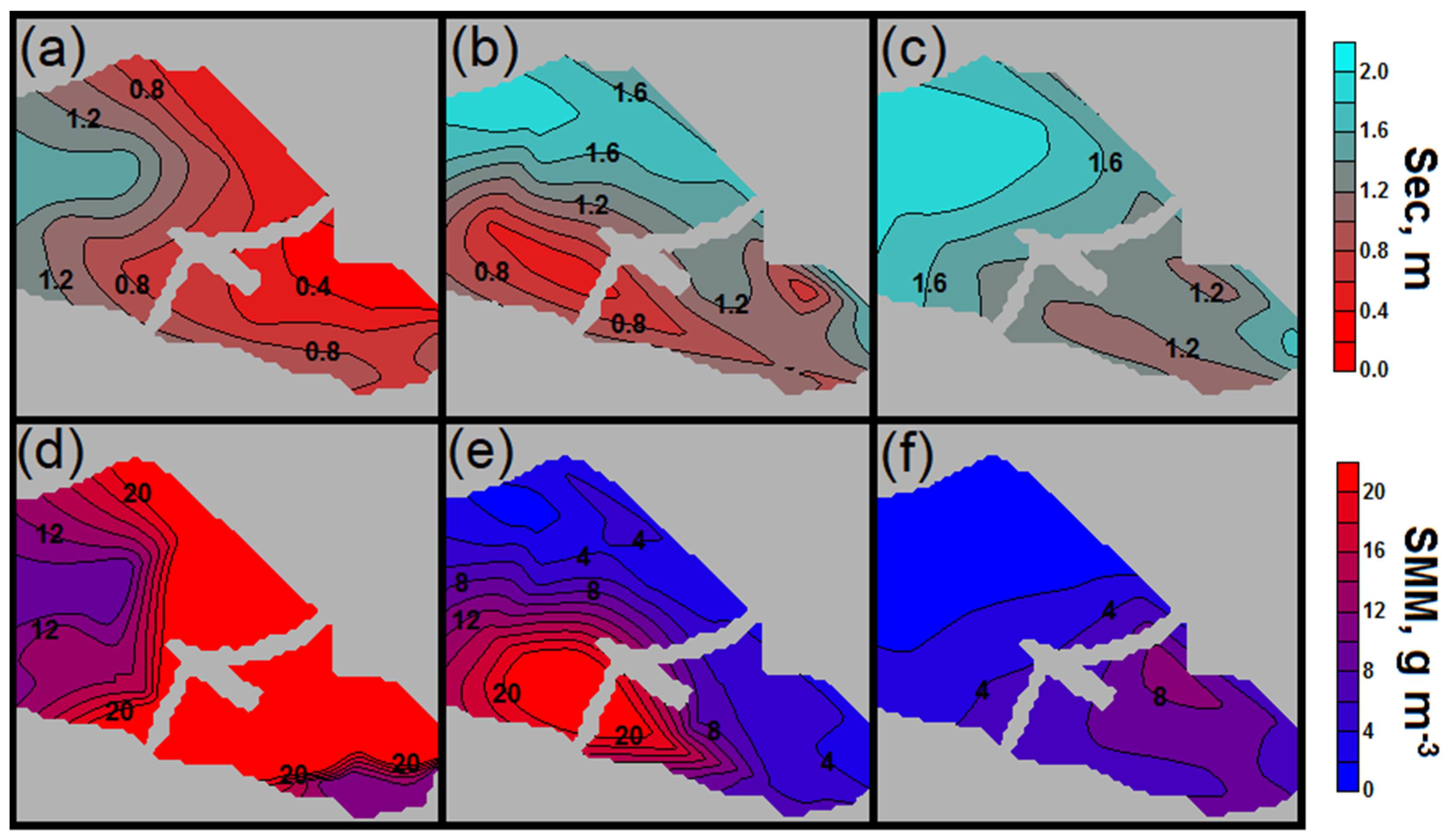

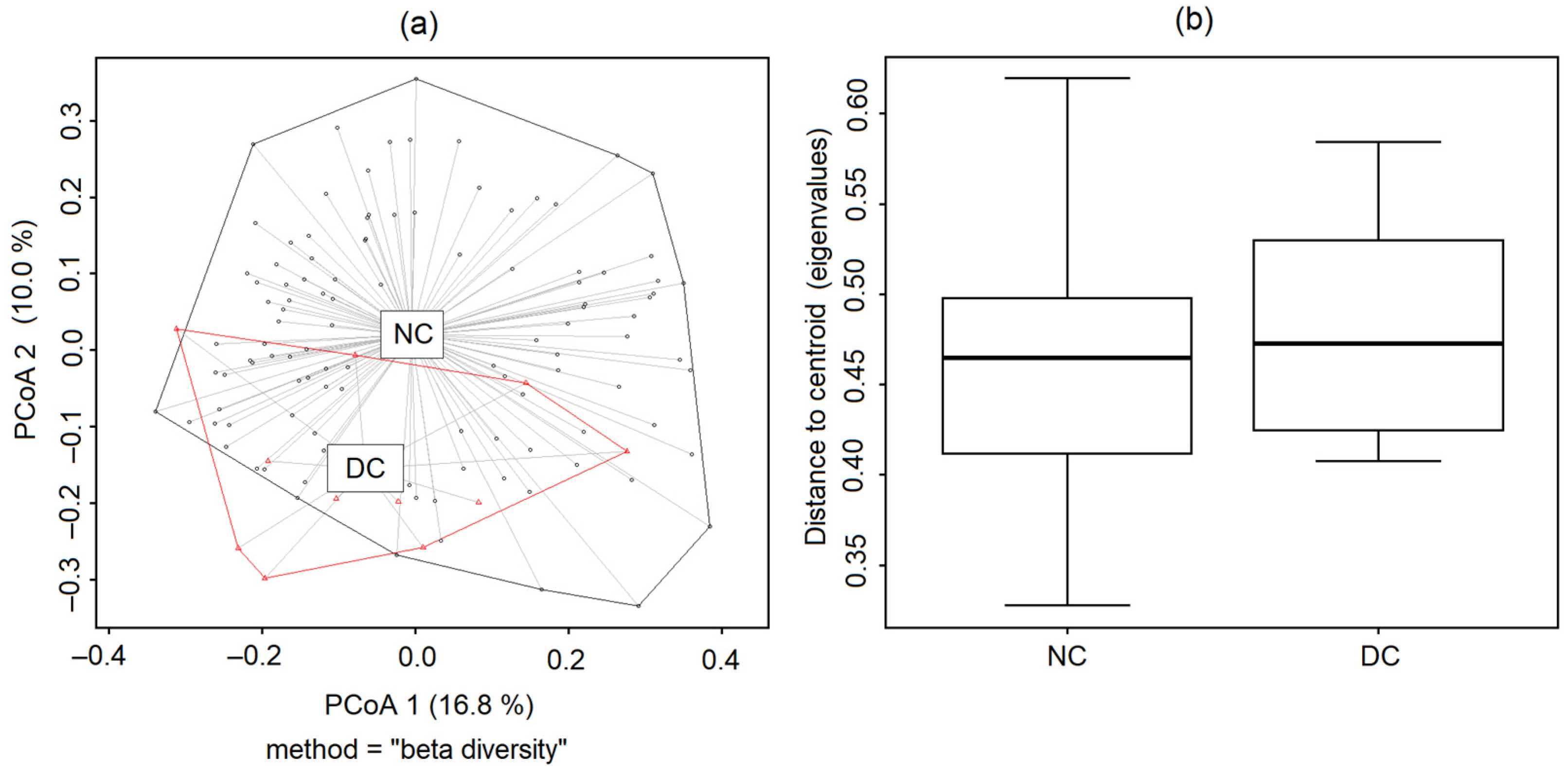
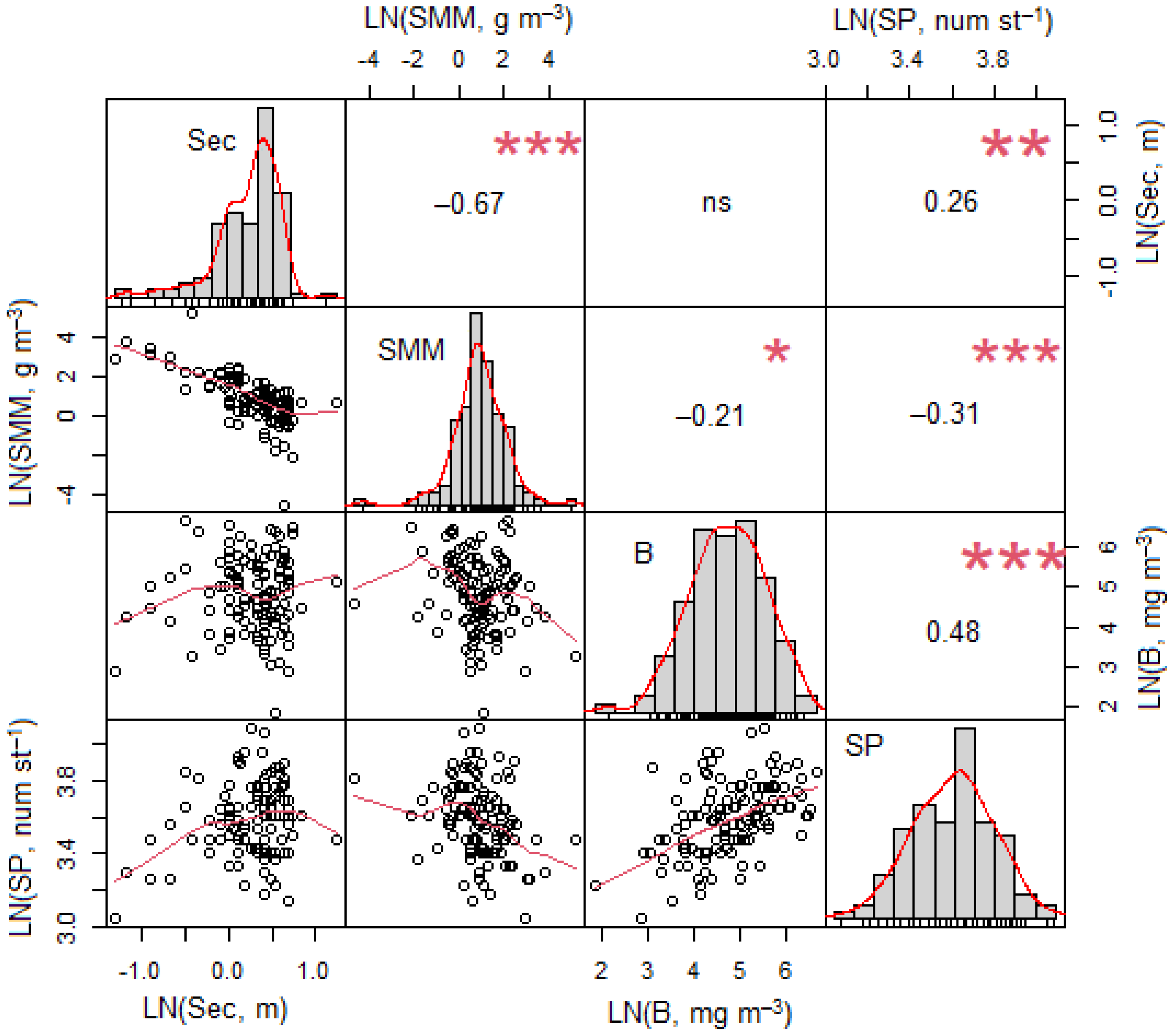
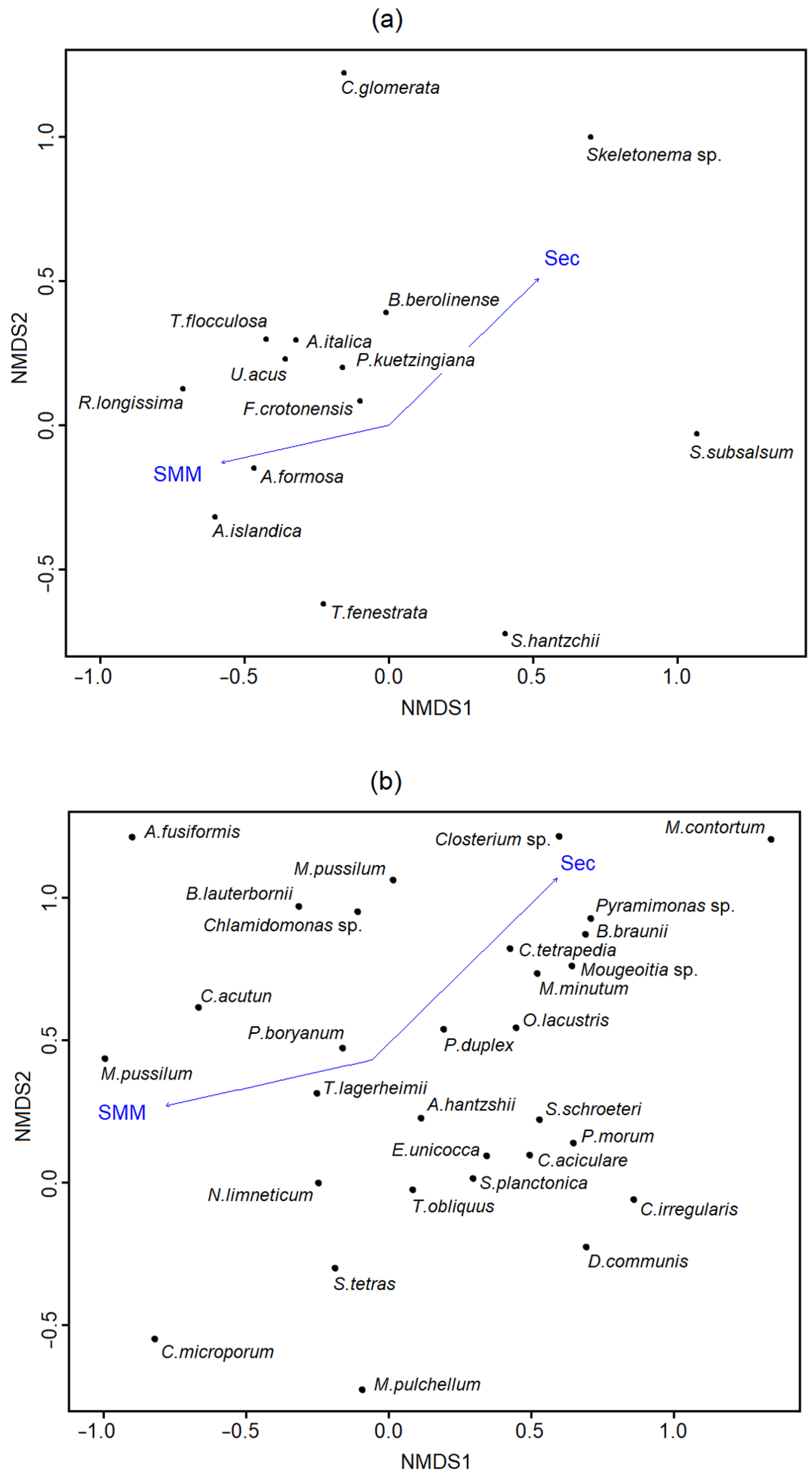
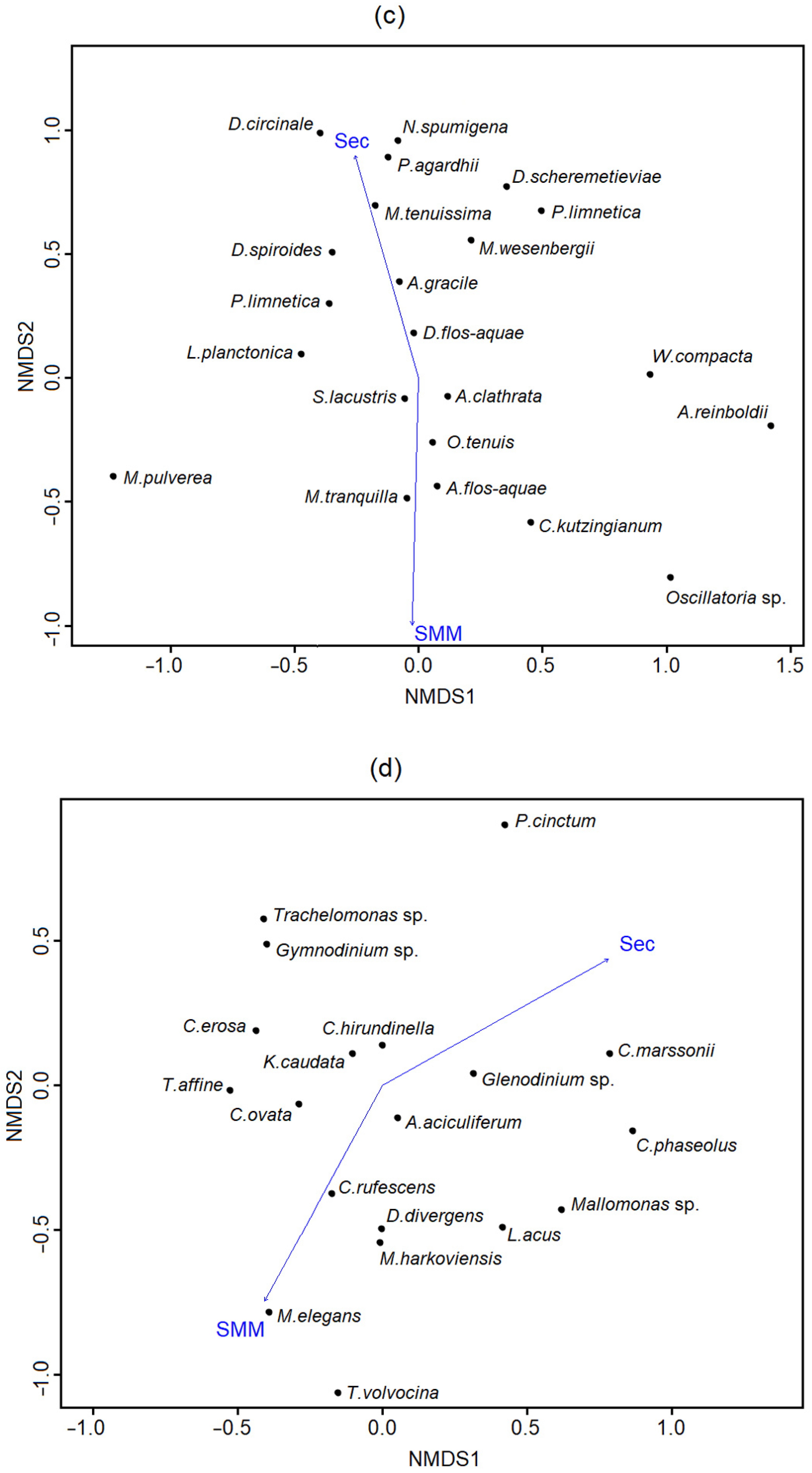
| Periods of Observation | 2006–2007 | 2014–2015 | 2003–2020 |
|---|---|---|---|
| S [PSU] | 0.33 ± 0.04 | 0.35 ± 0.02 | 0.37 ± 0.01 |
| T [°C] | 18.27 ± 0.19 | 20.86 ± 0.17 | 20.30 ± 0.02 |
| Groups of Phytoplankton | Number of Species | Predominant Species and Their Biomass (Minimum–Average–Maximum) [Wet Weight mg m−3] | ||
|---|---|---|---|---|
| DC | NC | DC | NC | |
| Bacillariophyceae | 12 | 23 | Skeletonema sp. (0–219.0–2409.0) | Skeletonema subsalsum (0–310.8–2528.1) |
| Skeletonema subsalsum (0–167.0–636.8) | Pantocsekiella kuetzingiana (0–302.2–16,127.4) | |||
| Aulacoseira islandica (0–96.6–678.3) | Aulacoseira islandica (0–247.4–3155.7) | |||
| Chlorophyceae | 25 | 56 | Chlamidomonas sp. (0–81.4–747.8) | Mougeotia sp. (0–158.1–2744) |
| Coelastrum microporum (0–32.4–288.0) | Mucidosphaerium pulchellum (0–145.8–7833.6) | |||
| Mucidosphaerium pulchellum (0–31.4–288.0) | Chlamidomonas sp. (0–63.4–2928.8) | |||
| Cyanophyceae | 19 | 28 | Planktothrix agardhii (0–300.0–2279.4) | Planktothrix agardhii (0–433.1–8800.0) |
| Limnothrix planctonica (0–137.1–686.2) | Dolichospermum flos-aquae (0–353.9–5153.8) | |||
| Dolichospermum flos-aquae (0–64.7–331.9) | Aphanizomenon flos-aquae (0–324.1–6389.9) | |||
| Chrysophyceae | 3 | 11 | Mallomonas charkoviensis (0–18.1–198.8) | Dinobryon divergens (0–43.3–1680.0) |
| Dinobryon divergens (0–2.1–21.6) | Mallomonas sp. (0–4.6–107.4) | |||
| Synura uvella (0–0.6–6.3) | Mallomonas harkoviensis (0–3.8–258.4) | |||
| Cryptophyceae | 4 | 6 | Cryptomonas erosa (0–544.1–1644.0) | Cryptomonas erosa (0–474.7–4384.0) |
| Cryptomonas ovata (0–299.9–3024.0) | Cryptomonas marssonii (0–258.1–2491.2) | |||
| Komma caudata (0–91.3–373.3) | Komma caudata (0–213.6–1296.9) | |||
| Dinophyceae | 6 | 8 | Gymnodinium sp. (0–269.8–2304.0) | Ceratium hirundinella (0–125.0–3200.0) |
| Peridinium cinctum (0–194.4–1200.0) | Peridinium cinctum (0–120.9–2662.4) | |||
| Ceratium hirundinella (0–46.6–296.0) | Apocalathium aciculiferum (0–72.4–2349.5) | |||
| Euglenophyceae | 3 | 4 | Trachelomonas sp. (0–265.8–2356.0) | Trachelomonas volvocina (0–125.8–4680.0) |
| Trachelomonas volvocina (0–5.0–33.9) | Lepocinclis acus (0–13.5–825.0) | |||
| Lepocinclis acus (0–0.6–6.6) | Trachelomonas sp. (0–10.9–876.4) | |||
| Xanthophyceae | 1 | 1 | Tribonema affine (0–12.1–187.0) | Tribonema affine (0–19.9–1177.5) |
Disclaimer/Publisher’s Note: The statements, opinions and data contained in all publications are solely those of the individual author(s) and contributor(s) and not of MDPI and/or the editor(s). MDPI and/or the editor(s) disclaim responsibility for any injury to people or property resulting from any ideas, methods, instructions or products referred to in the content. |
© 2022 by the authors. Licensee MDPI, Basel, Switzerland. This article is an open access article distributed under the terms and conditions of the Creative Commons Attribution (CC BY) license (https://creativecommons.org/licenses/by/4.0/).
Share and Cite
Golubkov, M.S.; Nikulina, V.N.; Golubkov, S.M. Impact of the Construction of New Port Facilities on the Biomass and Species Composition of Phytoplankton in the Neva Estuary (Baltic Sea). J. Mar. Sci. Eng. 2023, 11, 32. https://doi.org/10.3390/jmse11010032
Golubkov MS, Nikulina VN, Golubkov SM. Impact of the Construction of New Port Facilities on the Biomass and Species Composition of Phytoplankton in the Neva Estuary (Baltic Sea). Journal of Marine Science and Engineering. 2023; 11(1):32. https://doi.org/10.3390/jmse11010032
Chicago/Turabian StyleGolubkov, Mikhail S., Vera N. Nikulina, and Sergey M. Golubkov. 2023. "Impact of the Construction of New Port Facilities on the Biomass and Species Composition of Phytoplankton in the Neva Estuary (Baltic Sea)" Journal of Marine Science and Engineering 11, no. 1: 32. https://doi.org/10.3390/jmse11010032
APA StyleGolubkov, M. S., Nikulina, V. N., & Golubkov, S. M. (2023). Impact of the Construction of New Port Facilities on the Biomass and Species Composition of Phytoplankton in the Neva Estuary (Baltic Sea). Journal of Marine Science and Engineering, 11(1), 32. https://doi.org/10.3390/jmse11010032





